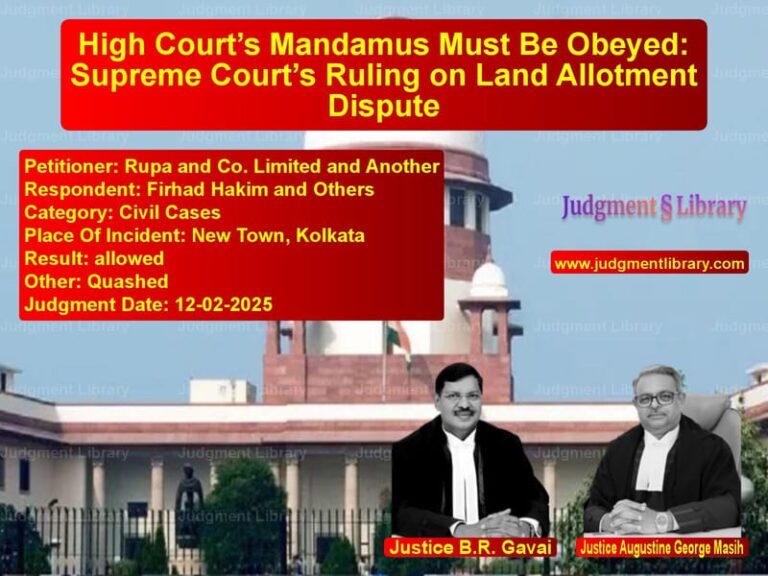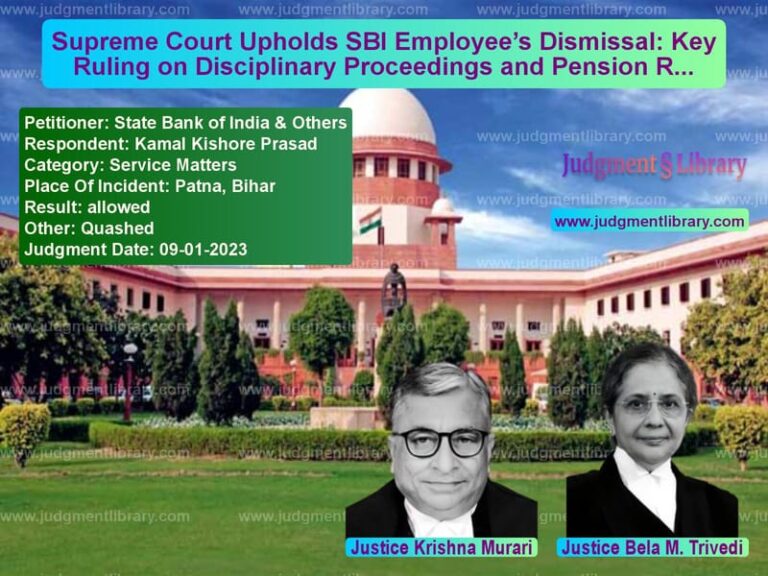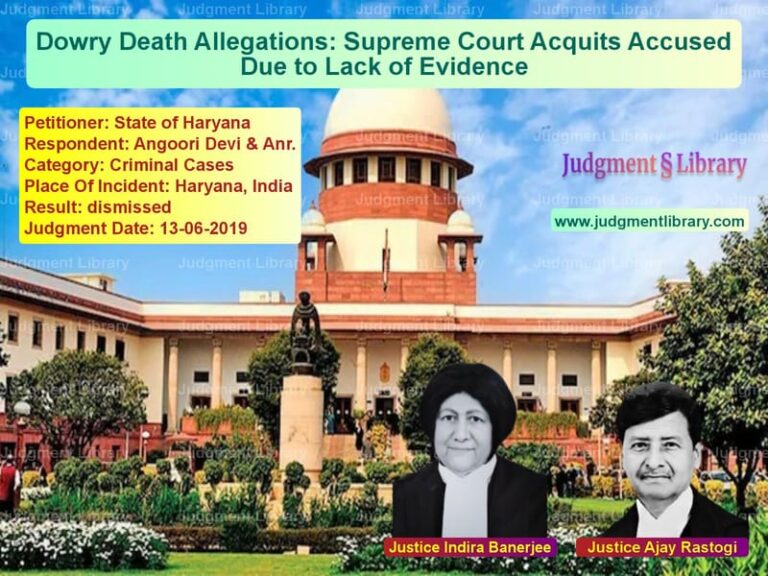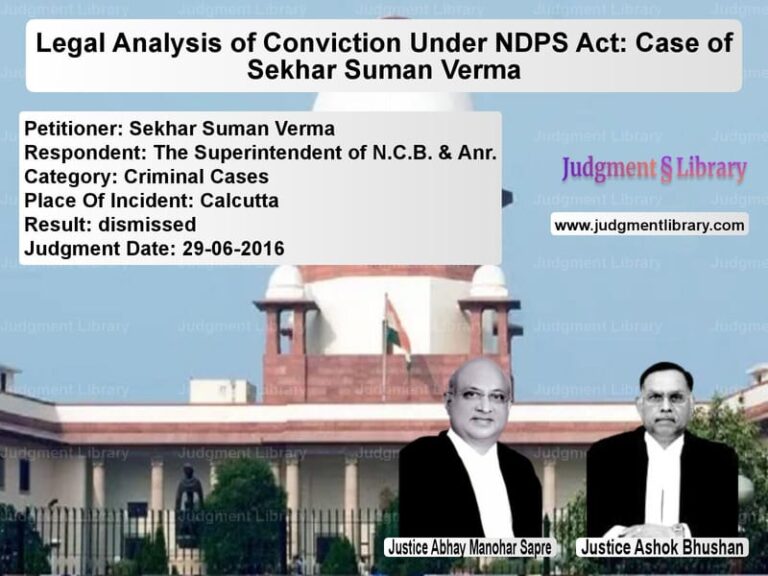Supreme Court Acquits Accused in Murder and Robbery Case Due to Lack of Evidence
The case of Sonu @ Sunil vs. State of Madhya Pradesh is a significant judgment concerning the principles of circumstantial evidence, the doctrine of common intention, and the admissibility of recovered property in criminal cases. The Supreme Court was called upon to examine whether the conviction of the appellant could be sustained solely on the basis of circumstantial evidence and the alleged recovery of stolen property.
Background of the Case
The appellant, Sonu @ Sunil, was tried along with four others and convicted under Sections 394, 460, and 302 read with Section 34 of the Indian Penal Code (IPC). Additionally, he was found guilty under Sections 11 and 13 of the Madhya Pradesh Dakaiti Avam Vyapharan Adhiniyam, 1981.
The trial court sentenced the appellant to death for the offence under Section 302 read with Section 34 of the IPC. However, the High Court commuted the death sentence to life imprisonment but maintained his conviction under other charges. The case revolved around the murder of Bharosilal on the night of September 8, 2008, at his residence in Bilaua, Madhya Pradesh.
Key Issues
- Was there sufficient evidence to convict the appellant beyond a reasonable doubt?
- Did the prosecution establish a continuous chain of circumstances linking the appellant to the crime?
- Could the recovery of a mobile phone from the appellant be considered conclusive evidence of his involvement?
- Did the doctrine of common intention under Section 34 IPC apply in this case?
Arguments of the Petitioner (Sonu @ Sunil)
The appellant argued that:
- There was no direct evidence linking him to the crime.
- The entire case rested on circumstantial evidence, which was insufficient to establish guilt beyond reasonable doubt.
- The prosecution relied heavily on the alleged recovery of a mobile phone, but there were inconsistencies in the identification of the phone and its ownership.
- PW5, who allegedly overheard a conversation among the accused planning the crime, was unreliable as there were inconsistencies in his testimony.
- He was not named in the initial investigation, and his arrest and subsequent implication were based on a weak chain of events.
Arguments of the Respondent (State of Madhya Pradesh)
The prosecution contended that:
- The case was built on strong circumstantial evidence, which included the recovery of stolen property.
- The appellant was found in possession of a mobile phone that belonged to the deceased.
- PW5 overheard the accused discussing their plan to rob and murder the deceased.
- The injuries on the deceased’s body indicated that he was attacked with sharp weapons, and one of the co-accused had recovered a knife.
- The murder and robbery were part of the same transaction, and hence, the appellant shared a common intention with the other accused under Section 34 IPC.
Supreme Court’s Judgment
The Supreme Court overturned the conviction and acquitted the appellant, ruling that the prosecution failed to establish the case beyond reasonable doubt. The key findings were:
1. Weaknesses in the Circumstantial Evidence
The Court reiterated the principle that circumstantial evidence must form an unbroken chain leading to the guilt of the accused. In this case, the evidence did not conclusively establish the appellant’s role in the crime:
“The circumstances must be fully established and must exclude every possible hypothesis except the guilt of the accused. Mere suspicion cannot take the place of legal proof.”
2. Inconsistencies in Recovery of the Mobile Phone
The Court found significant inconsistencies in the prosecution’s claim that the recovered mobile phone belonged to the deceased:
“There is a clear contradiction between the phone number provided by the deceased’s son and the one recovered from the appellant. The prosecution has failed to conclusively establish that the mobile phone belonged to the deceased.”
3. Reliability of PW5’s Testimony
The Court questioned the credibility of PW5, who claimed to have overheard the accused discussing the crime:
“The witness had no prior knowledge of the accused and could not clearly identify them. His testimony alone, without corroborative evidence, cannot be relied upon to convict the appellant.”
4. Lack of Direct Involvement and Common Intention
The Court ruled that the prosecution had not established that the appellant actively participated in the crime:
“For Section 34 IPC to apply, there must be clear evidence of common intention. The prosecution has failed to prove that the appellant had the same intention as the other accused.”
5. The Benefit of Doubt
The Court emphasized that in cases based entirely on circumstantial evidence, the benefit of doubt must be given to the accused:
“In the absence of a clear and convincing chain of evidence, the accused is entitled to the benefit of doubt. The conviction of the appellant cannot be sustained.”
Final Verdict
The Supreme Court set aside the High Court’s ruling and acquitted the appellant:
- The conviction under Sections 394, 460, and 302 read with Section 34 IPC was overturned.
- The death penalty was set aside, and the appellant was ordered to be released immediately unless required in another case.
- The Court reiterated the importance of due process and ensuring that convictions are based on reliable and substantial evidence.
Impact of the Judgment
This ruling has significant implications for criminal jurisprudence:
- It reinforces the importance of establishing a clear and unbroken chain of circumstantial evidence in criminal cases.
- It highlights the necessity of credible witness testimony and reliable forensic evidence.
- It emphasizes that suspicion, however strong, cannot replace legal proof in a criminal trial.
- It upholds the fundamental principle that an accused is entitled to the benefit of doubt in the absence of conclusive evidence.
Conclusion
The Supreme Court’s ruling in Sonu @ Sunil vs. State of Madhya Pradesh underscores the necessity of adhering to due process in criminal cases. By acquitting the appellant due to weak circumstantial evidence and inconsistencies in the prosecution’s case, the judgment reaffirms the importance of ensuring that every conviction is based on sound legal principles. This case serves as a reminder that courts must be cautious in relying on circumstantial evidence and must ensure that justice is served in accordance with the law.
Petitioner Name: Sonu @ Sunil.Respondent Name: State of Madhya Pradesh.Judgment By: Justice Sanjay Kishan Kaul, Justice K.M. Joseph.Place Of Incident: Madhya Pradesh.Judgment Date: 29-05-2020.
Don’t miss out on the full details! Download the complete judgment in PDF format below and gain valuable insights instantly!
Download Judgment: Sonu @ Sunil vs State of Madhya Prad Supreme Court of India Judgment Dated 29-05-2020.pdf
Direct Downlaod Judgment: Direct downlaod this Judgment
See all petitions in Murder Cases
See all petitions in Bail and Anticipatory Bail
See all petitions in Attempt to Murder Cases
See all petitions in Fraud and Forgery
See all petitions in Theft and Robbery Cases
See all petitions in Judgment by Sanjay Kishan Kaul
See all petitions in Judgment by K.M. Joseph
See all petitions in allowed
See all petitions in Quashed
See all petitions in supreme court of India judgments May 2020
See all petitions in 2020 judgments
See all posts in Criminal Cases Category
See all allowed petitions in Criminal Cases Category
See all Dismissed petitions in Criminal Cases Category
See all partially allowed petitions in Criminal Cases Category







